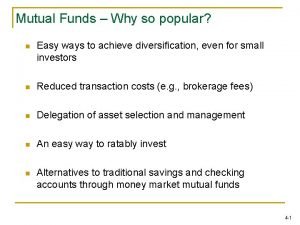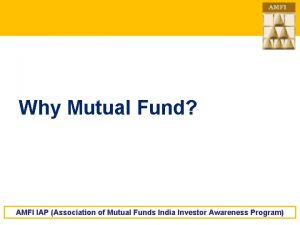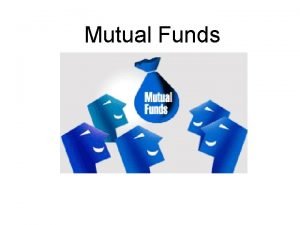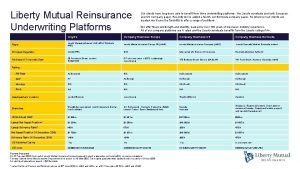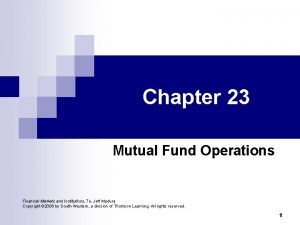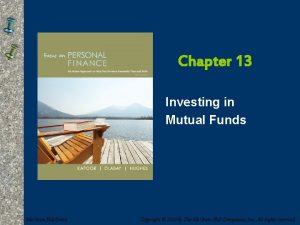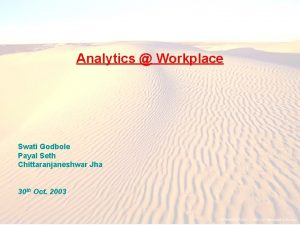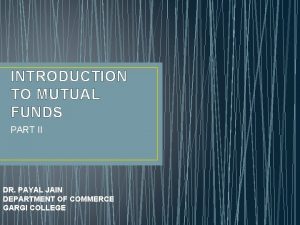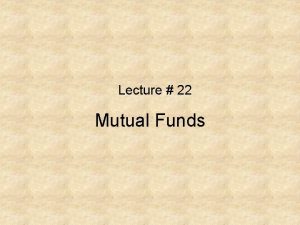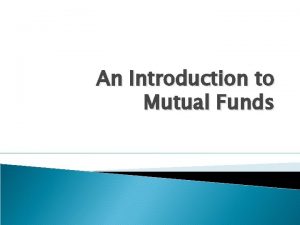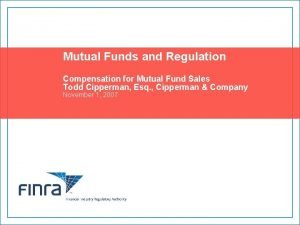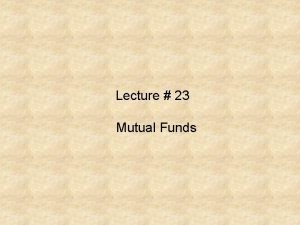INTRODUCTION TO MUTUAL FUNDS PART III DR PAYAL














- Slides: 14

INTRODUCTION TO MUTUAL FUNDS PART III DR. PAYAL JAIN DEPARTMENT OF COMMERCE GARGI COLLEGE

NAV, EXPENSES, ETC OF MUTUAL FUNDS

NET ASSET VALUE • Price of is stock is determined by demand supply forces. • On the other hand, a mutual fund’s value is determined by how much is invested in the fund as well as the costs to run it, and its number of outstanding shares. • Value of assets = value of all securities in the portfolio • Value of liabilities = value of all liabilities and fund expenses • The NAV of a fund is the fund’s per share market value • It is the price at which an investor would buy from or sell to the fund company. • NAV per unit tells us how much one share of the fund is worth.

NET ASSET VALUE…. contd. . • NAV per unit = Net Asset Value of the Fund / Number of Units Outstanding • Net Assets = [ Market Value of Investments + Receivables + Accrued Incomes + Other Assets ] [ Accrued Expenses + Payables + Other Liabilities ]

EXAMPLE • • • Value of securities = Rs. 75 lakh Cash = Rs. 15 lakh Accrued income = Rs. 24 lakh Short-term liabilities = Rs. 1 lakh Long-term liabilities = Rs. 12 lakh Number of outstanding shares = 20 lakhs • NAV per unit = [Rs. 75 lakh + Rs. 15 lakh + Rs. 24 lakh ][Rs. 1 lakh + Rs. 12 lakh] / 20 lakhs • NAV per unit = Rs. 101 lakh/20 lakh = Rs. 5. 05 per unit

COSTS INCURRED BY MUTUAL FUNDS • Every mutual fund house incurs expenses. • According to rules, mutual funds deduct a small portion from investors’ investments to pay for these expense • Equity funds are allowed to charge up to 2. 25% of the assets that a scheme manages. • Debt funds’ expenses are capped at 2%. • The lower the expense ratio of a scheme, the higher the NAV. • “However, while expense ratio is important, it should be borne in mind that it is not the only criterion while selecting mutual fund scheme. A scheme with a consistently decent track record, but a higher expense ratio may be better than the one which lower expense ratio, but gives poor returns”. - AMFI

COSTS OF NVESTING IN A MUTUAL FUND ANNUAL CHARGES DUE TO ON-GOING RECURRING EXPENSES (called Expense Ratio) ONE-TIME CHARGES or LOADS

ON-GOING/RECURRING EXPENSES • Asset management companies (AMCs) manage the assets of the mutual funds and take the investment decisions. • AMCs charge investors for professional fund management i. e. the investment management and advisory fees, which are charged annually. • Additionally, operating expenses such as sales & marketing / advertising expenses, administrative expenses, transaction costs, registrar fees, custodian fees, audit fees – are also charged as a percentage of the fund’s daily net assets.

EXPENSE RATIO = MANAGEMENT + OPERATING EXPENSES • The sum of management fees and operating fees is commonly referred to as ‘Expense Ratio’, which is charged annually. • Information on expense ratio applicable to a MF scheme is mentioned in the Scheme Information Document. For example, an expense ratio of 1% per annum means that each year 1% of a scheme’s total assets will be used to cover the expenses of managing and operating a scheme. • Management expense ratio (MER) or total expense ratio (TER) is expressed as a percentage of average Assets under Management (AUM) during a period. • Expense ratio = Expenses / Average AUM • As AUM goes up, expense ratio goes down.

LOADS = ONE-TIME CHARGES • Entry load: It is a front-end charge deducted from the NAV at the time of investing in a mutual fund scheme. SEBI abolished entry loads in August 2009. • Transaction charge: Starting August 2011, SEBI has allowed AMCs to collect a nominal amount as a one-time transaction fee. • If amount invested is less than Rs. 10000 – no transaction fee • If amount invested is more than Rs. 10000 by a first-time investor – Rs 150 • If amount invested is more than Rs. 10000 by an existing investor – Rs. 100 • In the case of Systematic Investment Plans (SIPs), where the total commitment towards the SIP is more than Rs. 10000, a transaction charge of Rs. 100 will be levied payable in four equal installments starting from the second to the fifth installment. • Exit Load: It is a charge levied when an investor redeems / sells his units in a short span of time since he made the investment. Mutual funds charge exit loads to deter investors

RETURN FROM MUTUAL FUND • ABSOLUTE RETURN • RISK-ADJUSTED RETURN

ABSOLUTE RETURN • Absolute return of mutual fund is compared with return on benchmark mutual fund. • Mutual Funds are required to declare their own benchmarks in Scheme Information Document. • The fund houses select benchmark indices on the basis of market capitalisation and sectoral or thematic strategies of the respective funds. For example, large-cap funds would have BSE SENSEX, BSE 100, Nifty 50 or Nifty 100 as their benchmark indices. Similarly, mid-cap funds would have Nifty Midcap 100 or Nifty Midcap 150 as their benchmark indices while infrastructure funds would use Nifty Infrastructure or BSE India Infrastructure India.

RISK-ADJUSTED RETURN • Sharpe ratio = (return on portfolio – risk-free rate of return) / standard deviation of the portfolio • Treynor’s Ratio = (return on portfolio – risk-free rate of return) / beta of the portfolio • Jensen’s Alpha = Fund’s Actual returns – Expected rate of returns • These numbers are usually given in a mutual fund’s fact sheet.

References • Investing in Stock Markets, Dr. Vanita Tripathi and Neeti Panwar, Taxmann’s. • Web resources such as • Moneycontrol. com • Amfiindia. com • Sebi gov. in
